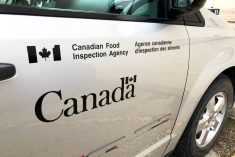Transport Canada has introduced new railway safety regulations aimed at reducing the risks associated with the transportation of dangerous goods such as gasoline, diesel fuel and crude oil.
Federal transport minister Lisa Raitt announced the measures April 23, suggesting the steps will protect Canadians and communities located along the country’s railway lines.
The regulations, which include reduced speeds for trains carrying dangerous goods, stem from a Transportation Safety Board of Canada investigation into a July 2013 train derailment and explosion that killed 47 people in Lac Megantic, Que.
Read Also

Women who fed a nation
More than 40,000 young women supported the war effort between the 1940s and early 1950s, helping grow and harvest crops amid labour shortages. They were called Farmerettes.
“The measures … improve the safety of the railway and transportation of dangerous goods systems from coast to coast to coast,” Raitt said in a news release.
These are among the new requirements:
• all trains hauling dangerous goods must reduce speeds to 50 miles per hour or less when moving through populated or high-risk areas
• all Dot-111 tanker cars used to transport crude oil and other dangerous goods must be retrofitted or removed from railway fleets within three years
• railway companies must develop emergency response assistance plans for trains that haul dangerous goods
• a task force including municipalities, first responders, railways and shippers must be created to discuss and strengthen emergency response efforts.
Canadian Pacific Railway welcomed the announcement that Dot-111 cars will be phased out but expressed disappointment with other parts of the regulations.
CP’s chief executive officer Hunter Harrison said in a news release that the company has long supported increased tank car safety standards but he said reducing train speeds is not a solution to rail safety because it is does not address accident causes.
CP has said the use of cameras in locomotives to monitor employees and the introduction of programs aimed at reducing grade crossings would be more effective ways to enhance rail safety.















